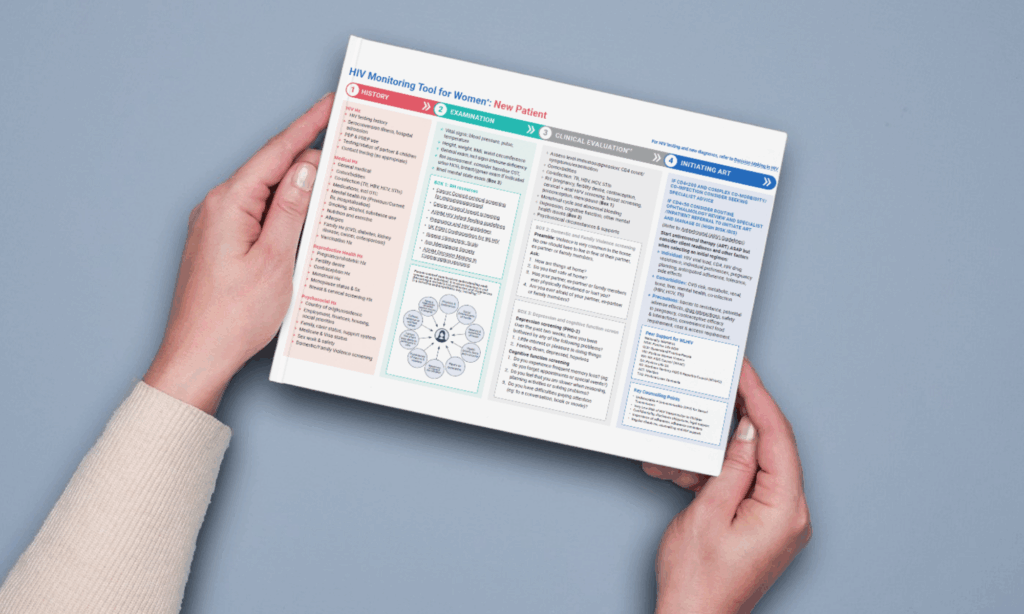New tool addresses critical gaps in care guidance for cisgender women living with HIV

Women living with HIV often have complex intersecting medical and psychosocial needs. The HIV Monitoring Tool for Women promotes an integrated, holistic, women-centered approach to providing HIV care for women in Australia. Women living with HIV experience greater multimorbidity at a younger age than men living with HIV, with most of these comorbidities carrying a higher […]
HIV Monitoring Tool for Women
This practical two-page resource outlines key considerations for the comprehensive monitoring of cisgender women living with HIV. The resource guides clinicians through history taking, examination, clinical evaluation, and initiation of antiretroviral therapy. This tool includes the initial and ongoing review schedule details assessment, frequency, and management advice for: This tool supports clinicians to deliver evidence-based […]
Doxy-PEP: Everything you need to know! Information Sheet
This printable resource provides clients, patients, and the community with comprehensive, easy-to-understand information about Doxy-PEP, including what it is, who it’s for, how it’s taken, its effectiveness, side effects, and cost. This resource was co-created by Health Equity Matters and ASHM.
Clinical Foundations of HIV
This eLearning course introduces the basics of HIV in Australia, as a foundation for further education and training in HIV. It is appropriate for all learners regardless of prior knowledge or experience in HIV. Course learning outcomes: By the end of this course, you will be able to: CPD: HIV s100 prescribers will receive 1 […]
Clinical Foundations of Hepatitis B
This eLearning course introduces the basics of hepatitis B in Australia. This module will introduce key concepts as a foundation for further education and training in hepatitis B and is appropriate for all levels of knowledge and experience. List of topics: By the end of this module, you will be able to: This course takes […]
Clinical Foundations of Hepatitis C
This eLearning course introduces the basics of hepatitis C (HCV) in Australia, as a foundation for further education and training in HCV. It is appropriate for all learners regardless of prior knowledge or experience in HCV. List of topics: By the end of this course, you will be able to: This course takes approximately 1 […]
NSW Introduction to Syphilis for Midwives and Clinicians Providing Antenatal Care
This online learning module is designed to provide midwives and clinicians providing antenatal care in NSW, with the tools to identify priority populations for antenatal syphilis testing in their practice, and distinguish the stages of syphilis infection based on a patient’s history and clinical presentation. This one-hour learning module will outline treatment guidelines for these […]
Hepatitis B Introductory Online Modules
These modules introduce key concepts for diagnosing and managing people living with chronic hepatitis B. After completing the modules, you will be able to: The modules will launch in a new window – if they do not open, please try enabling pop-ups and temporarily disable your ad blocker or firewall. Prospective HBV s100 prescribers:These modules are […]
Monkeypox (MPX) Vaccination Training
This module provides context for the monkeypox (MPX) outbreak and vaccination strategy within Australia, and describes the process for using the intradermal injection technique to administer the MPX vaccine. After completing this module, you will be able to: Please allow up to 45 minutes to complete this module. Further information, including any state-based unique jurisdictional requirements, please […]
Syphilis Outbreak Training Website
There is an ongoing outbreak of infectious syphilis in central and northern Australia among priority populations including young Aboriginal and/or Torres Strait Islander peoples and women of childbearing age. The current declared outbreak regions include rural and remote areas in Queensland, Northern Territory, Western Australia, and South Australia. Notification rates are also increasing significantly in […]

